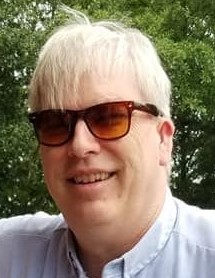Pastor’s Corner
of St. Martin’s Lutheran Church
Known for years as the “Congregation at Long Creek”, this congregation began to organize in April 1820, however; June 7, 1820 is the recognized date of the official organization of the Lutheran congregation that had been meeting in the home of Jacob Efird. Meetings continued in the Efird home until 1830 when a log church was built on 20 acres donated by Jacob Efird, to the “Congregation at Long Creek”. Paintings of the log church that served the congregation for 30 years are hanging in the educational wing hall and in the church office. (Figure 2)
In 1829, the congregation chose the name Saint Martin’s and was recognized by the Evangelical Lutheran Tennessee Synod. St. Martin’s continued to rely on supply pastors and pastors-in-training called “licensed deacons” until Adam Efird, a ‘son of the congregation’, served St. Martin’s in this capacity from 1848-1850. The desk he used while serving St. Martin’s is located in the Efird Library/Parlor. (Inside the top is a page of history). St. Martin’s finally got its own assigned minister, Reverend Timothy Moser, in 1865. He was assigned by the Evangelical Lutheran Tennessee Synod and St. Martin’s was made part of the parish, which consisted of five other churches located in Cabarrus County, all served by Reverend Moser until 1888. In 1902, The St. Martin’s congregation petitioned the Evangelical Lutheran Tennessee Synod, of which it had been a member since 1820, that it be released from that Synod in order that it might become part of the North Carolina Synod. The petition was approved and St. Martin’s became a member of the North Carolina Synod in 1903. In 1949, St Martin’s became self-supporting and was no longer required to be a parish member with other congregations. The first minister to serve St. Martin’s under this new status was Rev J.S. Wessenger.
In 1860, the log church was torn down and a frame church was built on the same site (Figure 3). Reportedly, this church had the largest seating area of any church in Stanly County at that time. The church had two front doors with aisles that ran from the doors to the front of the church with pews on left, middle, and right side of the church. Women, infants, and small children used the right entrance and sat on the right side of the church. Men and grown children entered and sat on the left side of the church. This frame structure served St. Martin’s for 48 years.
On October 1, 1909, the cornerstone was laid for a third St. Martin’s sanctuary. (Figure 4) A brick church was constructed, with a slate roof, bell tower and tall cathedral shaped stained glass windows. The bricks, made from clay were dug near Little Bear Creek on the farm of Ireneus P. Efird (Figure 5).
Lumber needed for construction was cut from church property and nearby farms. The church bell, purchased by John S. Efird, was hauled to the job site by horse and wagon from the railroad depot in Albemarle and is still being used in the current church building (Figure 6).
A final worship service and “Leave Taking” procession was held on January 19, 1969, when congregants carried hymnals, lectern bibles and various furnishings to the former Educational building that was converted to a chapel used for services until the new church was completed in June 1970. During the following week stained glass windows, church organ, pulpit, and remaining alter furnishings were moved to the interim chapel. When this building was torn down, alter furnishings, pulpit, and the stained glass windows were moved to the narthex and entrance of the current sanctuary.
On June 14, 1970, our congregation held its first service in our new church facility (Figure 7). Following the service a Cornerstone Laying Service was conducted with the NC Synod President Rev. George Whittecar and Pastor Karl Park presiding. A sealed copper box containing many historical church items and records were placed in this box.
Altar furnishings were preserved and are displayed throughout our current facility. The pulpit is located in the narthex, the lectern is near the front of the nave, the altar and pastor’s chairs, along with many old bibles and others items of interest are on display in the Efird Library/Parlor. Three stained glass windows have been reframed, specially housed, and backlit. Two are located in the narthex on either side of the main entrance (Figure 8a and 8b) and a third is above the doorway leading from the nave into the narthex (Figure 8c).
Records reveal that since organizing in 1820, a period of 198 years ago, our congregation has had only three ‘sons of the church’ enter into the Lutheran Ministry. In addition to Adam Efird, his brother Daniel started in 1850. A period of 114 years passed before the third, Harold McSwain in 1964. As of this date, a total of 35 pastors have served St. Martin’s Lutheran Church.
The first St. Martin’s Lutheran Church Cemetery is the site of unmarked graves for the Jacob Efird family and is located on Booger Holler Road, within site of the church. The current St Martin’s Lutheran Church cemetery, located adjacent to the Church, is also the site of marked and unmarked graves of additional members of the Efird family and early unknown congregants (Figure 9a and Figure 9b). Members of St Martin’s Lutheran Church Family all have family and stories that add to the rich history in the St Martin’s Lutheran Church Historical Cemetery.
We look forward to the 200th anniversary of St. Martin’s Lutheran Church in 2020.

Contact or Visit Us
Church Office Phone
704-982-7644
Pastor Phone
828-612-1595 (call or text)
Physical Address
16592 St. Martin Road
Albemarle NC 28001
Mailing Address
PO Box 429
Oakboro, NC 28129
Pastor Office Hours
Monday -Tuesday-Wednesday 10:00am - 2:00pm, by appointment
Thursday: Sermon Preparation Day
Friday: Day off

 Member of:
Member of: